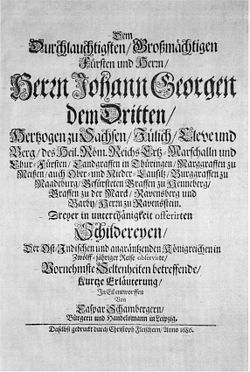Caspar Schamberger
Caspar Schamberger (1 September 1623 in Leipzig, Germany – 8 April 1706) was a German surgeon. His name represents the first school of Western medicine in Japan and the beginning of rangaku, or Dutch studies.



Schamberger grew up in war-torn Saxony. In 1637 he started studying surgery under the master surgeon of the surgeons guild in his native town of Leipzig. Three years late he finished his education and started traveling through Northern Germany, Denmark, Sweden, and the Netherlands. In 1643 he joined the Dutch East India Company (VOC), signing a contract for four years of service. Schamberger left Europe in the same year aboard the Eiland Mauritius, but the ship wrecked four months later near the Cape of Good Hope.
In July 1644 Schamberger finally arrived in
His treatment must have been quite successful. When the Dutch envoy finally returned to Nagasaki in spring 1650 four Europeans were requested to stay in Edo to give further instructions: Schamberger (surgery), Willem Bijlevelt (mathematics), the Swedish corporal Juriaen Schedel (mortar shooting), and Schedel's assistant Jan Smidt. After an exceptionally long stay in Edo the four went back to Nagasaki in October 1650. But Schamberger had to return again shortly after, participating in the annual journey to the court of the Dutch trading post chief. This time too he was called to the residences of high-ranking officials.
In April 1651, the Dutch entourage left for Nagasaki again. That November, Schamberger's service at Dejima ended, and he returned to Batavia. His interpreter Inomata Dembei, following orders from the governor of Nagasaki, had to draw up an extensive report on Schamberger's surgical art. This report and the contentment and continuous interest among high-ranking officials and feudal lords led to the birth of the so-called “Caspar-style-surgery" (kasuparu-ryû geka), the first Western-style school of medicine inspired by a surgeon stationed in Dejima.
In 1655, Schamberger returned to the Netherlands, traveling back to Leipzig a few weeks after. In 1658 he acquired citizenship in Leipzig and started a new career as a merchant. He married three times: to Elisabeth Rost in 1659, to Regina Maria Conrad in 1662, and to Euphrosine Kleinau in 1685. In 1667 his son Johann Christian Schamberg was born. Johann later became a Professor of Medicine at Leipzig University and was elected president twice. One of his greatest achievements was the foundation of the "New Anatomical Theatre".
In 1686, Schamberger published an extensive description of three illustrations depicting a great variety of people, exotic fruits, coins, animals, and artifacts he had observed all over "East India". It is dedicated to the Duke elect Johann III. Only one copy of this private print is preserved.[1]
In 1706, Schamberger died, only to be followed shortly after by his son.
Schamberger's name stands for the beginning of a lasting interest in Western style medicine that gradually led to the upcoming of the so-called Dutch Studies (rangaku) in early modern Japan.
Works
- Dem Durchlauchtigsten Großmächtigen Fürsten und Herrn Herrn Johann Georgen dem Dritten Hertzogen zu Sachsen [...] Dreyer in unterthänigkeit offerirten Schildereyen Der Ost Indischen und angräntzenden Königreichen in Zwölff=jähriger Reise observirte Vornehmste Seltenheiten betreffende Kurtze Erläuterung In Eil entworffen Von Caspar Schambergern Bürgern und Handelsmann in Leipzig. Daselbst gedruckt durch Christoph Fleischern Anno 1686.
References
- Reiner H. Hesselink: Prisoners from Nambu: Reality and Make-Believe in Seventeenth-Century Japanese Diplomacy. University of Hawaii Press, 2002.
- Wolfgang Michel: Von Leipzig nach Japan - Der Chirurg und Handelsmann Caspar Schamberger. Iudicium, Muenchen 1999. (ISBN 3-89129-442-5)
- Wolfgang Michel: «Der Ost-Indischen und angrenzenden Königreiche, vornehmste Seltenheiten betreffende kurze Erläuterung» - Neue Funde zum Leben und Werk des Leipziger Chirurgen und Handelsmanns Caspar Schamberger (1623–1706). Kyushu University, The Faculty of Languages and Cultures Library No 1. Fukuoka: Hana-Shoin 2010. (
- Wolfgang Michel: Medicine and Allied Sciences in the Cultural Exchange between Japan and Europe in the Seventeenth Century. In: Hans Dieter Ölschleger (ed.): Theories and Methods in Japanese Studies: Current State & Future Developments - Papers in Honor of Josef Kreiner. Vandenhoeck & Ruprecht Unipress, Göttingen, 2007, pp. 285–302; (pdf file: Kyushu University Repository)
- Wolfgang Michel: »Der Ost-Indischen und angrenzenden Königreiche, vornehmste Seltenheiten betreffende kurze Erläuterung«: Neue Funde zum Leben und Werk des Leipziger Chirurgen und Handelsmanns Caspar Schamberger (1623–1706). Kyushu University, The Faculty of Languages and Cultures Library, No 1. Fukuoka: Hana-Shoin, 2010. )
References
- ^ Michel (2010)
